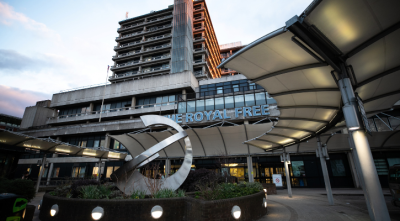The pulmonary hypertension (PH) team at the Royal Free Hospital is a dedicated team of specialists committed to providing world-class care and expertise to patients suffering from pulmonary hypertension.
The team is focused on delivering the best possible outcomes for our patients, through use of the latest technology, ground-breaking research and a wealth of experience.
The pulmonary hypertension team was established in 2003, in recognition of the need for specialised care for this unique patient population.
Over the years, thousands of patients have been treated, making a tangible difference in their lives, and the department is now a leading centre for PH care in the country.
The department is at the forefront of research into pulmonary hypertension and can offer patients access to the latest clinical trials.
The team is comprised of:
- consultant physicians (cardiology, respiratory and rheumatology specialists)
- specialist nurses
- radiologists
- specialist pharmacists
- counsellor
- dedicated administrative staff
Imagine the blood vessels in the lungs as a set of highways. In people with PH, these highways become narrow, making it hard for blood to flow through easily.
This means the heart has to work hard to get blood through to the lungs where it picks up fresh oxygen. Over time, this extra work can make the heart tired and less efficient.
If not taken care of, it can cause serious heart problems.
People with PH often feel:
- out of breath, even during simple activities like walking
- very tired, even when they have not done much
- light-headed or dizzy, especially when they are active
- a feeling of pressure or pain in their chest, usually when they are moving around
- swollen feet and ankles, caused by fluid building up in the body
- a bluish tint to lips or skin, because not enough oxygen-rich blood is reaching the body parts
There are different types of PH. Some are linked to other health problems, while others happen without a clear reason.
No matter what the type is, it is essential to spot it early and get the right care.
Watch our video about pulmonary hypertension.
CTEPH is a form of pulmonary hypertension caused by chronic blood clots in the lungs that have become ‘organised’ and fibrous over time, obstructing the pulmonary arteries.
These clots resist natural dissolution and lead to increased resistance in the pulmonary arteries, causing the heart to work harder to pump blood through them. This added strain can result in the heart weakening over time.
CTEPH can potentially be cured with surgical intervention known as pulmonary endarterectomy (PEA), a procedure that removes the obstructive clots from the arteries.
For patients not suitable for surgery or those with persistent or recurrent pulmonary hypertension after PEA, targeted procedures (such as balloon pulmonary angioplasty) or medical therapies may be used.
Over the years, researchers have learned a lot about how PH works and what causes it. This has led to new and better treatments.
There are now different medicines that can help open up the blood vessels in the lungs, making it easier for the heart to pump blood.
This means people with the condition can breathe easier, feel better and stay more active.
There have also been improvements in surgeries that can help some people with this condition.
There are different categories of treatment for PH:
- Phosphodiesterase type 5 (PDE5) inhibitors: these drugs help relax and widen the blood vessels in the lungs, making it easier for the heart to pump blood.
- Endothelin receptor antagonists (ERAs): these drugs block the effect of endothelin, a substance in the walls of blood vessels that causes them to narrow. By doing so, ERAs help to widen the blood vessels and reduce blood pressure in the lungs.
- Prostacyclins: these are similar to a natural substance found in the body which widens blood vessels and inhibits blood clotting.
- Calcium channel blockers: these drugs help to relax the muscles in the walls of blood vessels.
- Soluble guanylate cyclase (sGC) stimulators: these drugs help relax and widen the arteries in the lungs, increasing the flow of blood and lowering pulmonary artery pressure.
- Surgical and interventional procedures: in cases where medication might not be sufficient, surgical interventions such as lung transplantation can be considered.
A comprehensive range of PH services are provided to patients:
Diagnostic services
Our state-of-the-art facilities include advanced imaging and diagnostic tools, ensuring accurate diagnosis and tailored treatment strategies.
Treatment and management
From drug therapies to advanced surgical interventions, cutting-edge treatments are offered, backed up by the latest research.
Psychological support
Living with PH can be challenging. Patients and their families are given emotional and mental health support by the team counsellor.
Education and training
Patients receive education from the team’s specialist nurses, to ensure they are informed about their condition and their treatments.
Our commitment to excellence has established us as a leading centre for pulmonary hypertension care in a number of areas:
Research
Our team is at the forefront of pulmonary hypertension research, collaborating with international partners to understand the disease better and develop novel treatment strategies.
We are able to offer access to the latest research in therapeutics through our participation in multi-centre clinical trials.
We have also been awarded peer-reviewed grant funding from the British Heart Foundation for research into pulmonary hypertension.
Training
As a teaching hospital, we are responsible for shaping the next generation of pulmonary hypertension specialists. Our programmes emphasise both clinical acumen and compassionate care.
Multidisciplinary approach
We believe in a holistic approach to care. Our multidisciplinary team collaborates regularly and closely, ensuring every aspect of a patient’s condition is addressed.
The PH team’s consultant physicians are experienced doctors who specialise in diagnosing, treating and managing PH. They are experienced at recognising the subtle signs of PH and use a combination of clinical evaluation and advanced testing to confirm diagnoses.
Once a diagnosis is made, your consultant physician will devise a comprehensive treatment plan, tailored to you. This might involve medications, lifestyle recommendations or, in some cases, surgical interventions.
Your consultant will spend time discussing the diagnosis, potential treatments and prognosis with you, ensuring you feel informed and involved in your care journey.
The PH team’s specialist nurses have specific training and knowledge about PH. They are there for you and provide reassurance and answer questions.
They often become the main point of contact for our patients, providing a familiar and comforting presence throughout your journey. They will explain everything to you, and help you and your family understand what to expect, how to manage symptoms and when to seek further help.
The specialist nurses administer medicines, monitor how well your treatment is working, ensure you are comfortable, are alert to any potential side effects or complications, and will monitor and support you after your initial treatment.
Managing pulmonary hypertension is a journey that benefits immensely from a collaborative approach.
Shared care, a system where healthcare professionals come together to provide comprehensive care, proves invaluable in addressing the complex needs of patients with this condition.
At the Royal Free Hospital, we have set up a network of shared care providers for pulmonary hypertension.
These providers are located across a wide region — including Plymouth, Portsmouth, Bath, Belfast, Brighton, London, Margate, Coventry and Northampton.
In each case, Royal Free London consultants work closely with local specialist teams to provide patients with access to specialist care, as well as support from local healthcare professionals.
HYPERION
This study is testing a drug called Sotatercept for treating pulmonary arterial hypertension (PAH). Sotatercept is believed to make the walls of the blood vessels in the lung thinner and lets more blood into the lung blood vessels, and therefore may help improve shortness of breath and increase the maximum amount of exercise that can be done.
IMPAHCT
This study is testing a drug called imatinib for treating pulmonary arterial hypertension. Imatinib is inhaled into the lungs via the mouth, and it is used to block enzymes that activate proteins that thicken the pulmonary artery, which makes it difficult for blood to flow between the lungs and the heart.
Insmed
This study is exploring a drug called Treprostinil Palmitil powder (TPIP) for treating pulmonary arterial hypertension.
National Cohort
This study aims to recruit patients with pulmonary arterial hypertension, and their relatives, and follow them up for several years.
ROR-PH-301
This study is testing a drug called Ralinepag to treat pulmonary arterial hypertension (PAH). Ralinepag may improve the blood flow to the lungs, which may improve symptoms of PAH, such as shortness of breath, and dizziness.
ROR-PH-303
This is an open label extension study to ROR-PH-301, which means that everyone will receive Ralinepag.
SOTERIA
This study is testing a drug called Sotatercept to see how safe and effective the drug is.
UNISUS
This study is testing a drug called Macitentan to see how tolerable and safe it is for treating pulmonary arterial hypertension. Macitentan helps to widen the arteries in the lungs and thereby bring down blood pressure.
Beyond Detect
This is a follow on study from the Detect Study. The aim of this study is to diagnose pulmonary arterial hypertension (PAH) earlier in patients with scleroderma using the DETECT clinical tool, which uses simple clinical and echocardiographic calculations to predict the likelihood of PAH and thereby improving patient outcomes.
CompERA
This study is collecting long term data (registry study) so that the treatment of pulmonary hypertension may be improved in future. The study will document the progress of patients by evaluating medical data before, during and after treatment of pulmonary hypertension.
EXPOSURE
This study is collecting information (observational study) for patients who have started Uptravi or another drug for pulmonary arterial hypertension so that the medical practice and safety of specific treatments can be understood better.
FLASH
This study is evaluating the safety and effectiveness of the FlowTriever System for use in the removal of emboli from the pulmonary arteries in the treatment of acute pulmonary embolism.
HI-PEITHO
This study is comparing two treatment options for the treatment of pulmonary embolism. Patients will receive either anticoagulation (blood thinners) to prevent another blood clot, or patients will receive anticoagulation in combination with a device called EkoSonic™ Endovascular device, to dissolve blood clots. This will determine whether the combination treatment can increase survival compared to anticoagulation medication alone.
Referrals are welcomed from clinicians, for patients with potential pulmonary hypertension. To refer a patient:
- Email us: rf-tr.
royalfreepah .@nhs.net - Investigation reports: if possible, please include recent investigation reports such as HRCT, VQ, PFT and echo with your referral to aid in our comprehensive evaluation.
- Timely referrals: you are encouraged not to delay referrals, even if all investigations are not available. Ensuring timely referral can be pivotal for patients.
The Pulmonary Hypertension Association UK (PHA UK) is a prominent UK charity dedicated to people diagnosed with pulmonary hypertension.
Established to offer support, understanding, and information, PHA UK has been a beacon of hope for many affected by this condition. PHA UK provides:
- Patient support: one of the primary aims of PHA UK is to offer emotional and practical support to patients and their families. Through various initiatives, they help individuals come to terms with the diagnosis and navigate the challenges of living with PH.
- Awareness and education: PHA UK works to educate both the public and healthcare professionals on PH. Their efforts ensure PH is better understood, leading to earlier diagnoses and improved patient care.
- Research advocacy: while significant strides have been made in understanding and treating PH, there is still much to learn. PHA UK actively supports and funds research endeavors to unearth new treatments, better diagnostic tools, and, eventually, a cure.
- Community building: through events, meetings and forums, PHA UK fosters a sense of community among those affected by PH. These gatherings offer patients a platform to share experiences, gain insights and form bonds with others.
- Resources and publications: PHA UK provides a range of resources aimed at keeping patients and families informed about the latest in PH research, care and lifestyle tips.
Coming to a new hospital unit can feel overwhelming, but we are here to make the process as smooth and comfortable as possible.
When you are referred to our unit at the Royal Free Hospital, here is what you can typically expect:
- Warm welcome: our friendly staff will greet you and guide you through the day's schedule.
- Discussion: a doctor or nurse will chat with you about your symptoms, your medical history, and any concerns you might have.
- Physical examination: we will do a general check-up, just like in a regular doctor's visit, to understand your overall health.
To find out if someone has pulmonary hypertension, we usually do a few tests. Think of these as tools that help us get a clear picture of what's going on inside the body:
- Breathing test (lung function test): this helps us see how well your lungs are working. You will take deep breaths into a tube connected to a machine.
- Heart sound recording (echocardiogram): this is like an ultrasound but for the heart. It lets us see how your heart beats and pumps blood.
- Chest picture (X-ray): it gives us a snapshot of your lungs and heart.
- Blood tests: just a simple blood draw that can tell us a lot about your overall health and how well your organs are working.
- Exercise test: here, we will ask you to walk for a certain time to understand how active you can be without feeling breathless or tired.
- Cardiac MRI: this is a specialised imaging test where we use magnetic fields and radio waves to create detailed pictures of your heart and its vessels. It provides a wealth of information on the structure and function of your heart, helping us to plan the best pathway of care for you.
Depending on what these tests show, there might be a few other specialised tests we could consider, but we will always discuss and explain why we think they're necessary.
Once we have the results from all the tests:
- Discussion time: our team will sit down with you to chat about the findings. We will explain everything in simple terms and answer any questions you might have.
- Next steps: if it turns out you have pulmonary hypertension or another condition, we will discuss the best ways to take care of it, which might include medicines, lifestyle advice, or sometimes further tests.
Remember, our primary goal is to ensure you feel informed, comfortable, and supported throughout your journey with us.
Watch our video about testing for pulmonary hypertension.
Right heart catheterisation is a safe and common test that helps provide detailed information on how your heart is working.
Before the test, you will be asked not to eat or drink for a few hours.
On the day of the test, you will lie down on a comfortable table and your doctor will carefully insert the catheter into a blood vessel, guiding it towards your heart. This might sound scary, but you will not feel any pain — maybe just a slight pinch or pressure when the catheter goes in.
The test usually lasts less than an hour.
The team will analyse the information from the test and discuss the findings with you, and answer any questions you have.
Depending on the results, you will be told about the next steps, whether that is starting a new treatment or making some lifestyle changes.
 Translate
Translate







